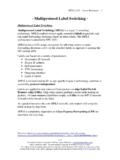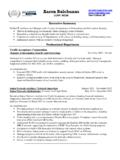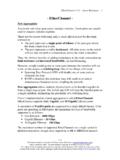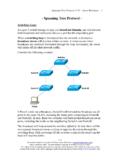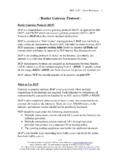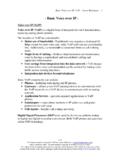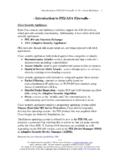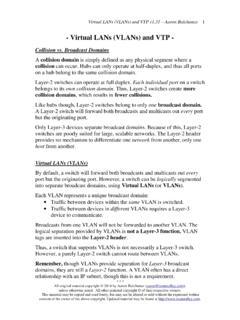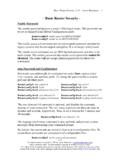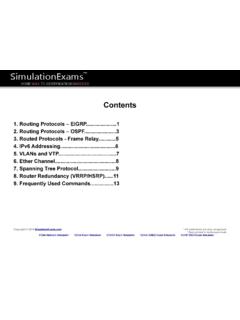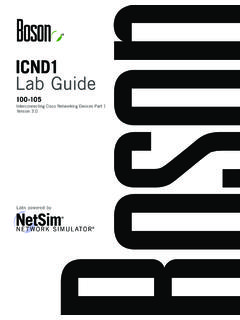Transcription of Enhanced Interior Gateway Routing Protocol
1 eigrp Aaron Balchunas * * * All original material copyright 2007 by Aaron Balchunas unless otherwise noted. All other material copyright of their respective owners. This material may be copied and used freely, but may not be altered or sold without the expressed written consent of the owner of the above copyright. Updated material may be found at 1 - Enhanced Interior Gateway Routing Protocol - eigrp ( Enhanced Interior Gateway Routing Protocol ) eigrp is a Cisco-proprietary Hybrid Routing Protocol , incorporating features of both Distance-Vector and Link-State Routing protocols. eigrp adheres to the following Hybrid characteristics: eigrp uses Diffusing Update Algorithm (DUAL) to determine the best path among all feasible paths. DUAL also helps ensure a loop-free Routing environment. eigrp will form neighbor relationships with adjacent routers in the same Autonomous System (AS).
2 eigrp traffic is either sent as unicasts, or as multicasts on address , depending on the eigrp packet type. Reliable Transport Protocol (RTP) is used to ensure delivery of most eigrp packets. eigrp routers do not send periodic, full-table Routing updates. Updates are sent when a change occurs, and include only the change. eigrp is a classless Protocol , and thus supports VLSMs. Other characteristics of eigrp include: eigrp supports IP, IPX, and Appletalk Routing . eigrp applies an Administrative Distance of 90 for routes originating within the local Autonomous System. eigrp applies an Administrative Distance of 170 for external routes coming from outside the local Autonomous System eigrp uses Bandwidth and Delay of the Line, by default, to calculate its distance metric. It also supports three other parameters to calculate its metric: Reliability, Load, and MTU. eigrp has a maximum hop-count of 224, though the default maximum hop-count is set to 100.
3 eigrp , much like OSPF, builds three separate tables: Neighbor table list of all neighboring routers. Neighbors must belong to the same Autonomous System Topology table list of all routes in the Autonomous System Routing table contains the best route for each known network eigrp Aaron Balchunas * * * All original material copyright 2007 by Aaron Balchunas unless otherwise noted. All other material copyright of their respective owners. This material may be copied and used freely, but may not be altered or sold without the expressed written consent of the owner of the above copyright. Updated material may be found at 2 eigrp Neighbors eigrp forms neighbor relationships, called adjacencies, with other routers in the same AS by exchanging Hello packets. Only after an adjacency is formed can routers share Routing information. Hello packets are sent as multicasts to address By default, on LAN and high-speed WAN interfaces, eigrp Hellos are sent every 5 seconds.
4 On slower WAN links (T1 speed or slower), eigrp Hellos are sent every 60 seconds by default. The eigrp Hello timer can be adjusted on a per interface basis: Router(config-if)# ip hello-interval eigrp 10 7 The above command allows us to change the hello timer to 7 seconds for Autonomous System 10. In addition to the Hello timer, eigrp neighbors are stamped with a Hold timer. The Hold timer indicates how long a router should wait before marking a neighbor inactive, if it stops receiving hello packets from that neighbor. By default, the Hold timer is three times the Hello timer. Thus, on high-speed links the timer is set to 15 seconds, and on slower WAN links the timer is set to 180 seconds. The Hold timer can also be adjusted on a per interface basis: Router(config-if)# ip hold-interval eigrp 10 21 The above command allows us to change the hold timer to 21 seconds for Autonomous System 10.
5 Changing the Hello timer does not automatically change the Hold timer. Additionally, Hello and Hold timers do not need to match between routers for an eigrp neighbor relationship to form. (Reference: #eigrp_work) eigrp Aaron Balchunas * * * All original material copyright 2007 by Aaron Balchunas unless otherwise noted. All other material copyright of their respective owners. This material may be copied and used freely, but may not be altered or sold without the expressed written consent of the owner of the above copyright. Updated material may be found at 3 eigrp Neighbors (continued) A neighbor table is constructed from the eigrp Hello packets, which includes the following information: The IP address of the neighboring router. The local interface that received the neighbor s Hello packet. The Hold timer. A sequence number indicating the order neighbors were learned.
6 Adjacencies will not form unless the primary IP addresses on connecting interfaces are on the same subnet. Neighbors cannot be formed on secondary addresses. If connecting interfaces are on different subnets, an eigrp router will log the following error to console when a multicast Hello is received: 00:11:22: IP- eigrp : Neighbor not on common subnet for Serial0 Always ensure that primary IP addresses belong to the same subnet between eigrp neighbors. To log all neighbor messages and errors to console, use the following two commands: Router(config)# router eigrp 10 Router(config-router)# eigrp log-neighbor-changes Router(config-router)# eigrp log-neighbor-warnings (Reference: ) eigrp Aaron Balchunas * * * All original material copyright 2007 by Aaron Balchunas unless otherwise noted. All other material copyright of their respective owners. This material may be copied and used freely, but may not be altered or sold without the expressed written consent of the owner of the above copyright.
7 Updated material may be found at 4 The eigrp Topology Table Once eigrp neighbors form adjacencies, they will begin to share Routing information. Each router s update contains a list of all routes known by that router, and the respective metrics for those routes. All such routes are added to an eigrp router s topology table. The route with the lowest metric to each network will become the Feasible Distance (FD). The Feasible Distance for each network will be installed into the Routing table. The Feasible Distance is derived from the Advertised Distance of the router sending the update, and the local router s metric to the advertising router. Confused? Consider the following example: Router A has three separate paths to the Destination Network, either through Router B, C, or D. If we add up the metrics to form a distance (the metrics are greatly simplified in this example), we can determine the following: Router B s Feasible Distance to the Destination Network is 8.
8 Router C s Feasible Distance to the Destination Network is 23. Router D s Feasible Distance to the Destination Network is 9. Router B sends an update to Router A, it will provide an Advertised Distance of 8 to the Destination Network. Router C will provide an AD of 23, and D will provide an AD of 9. Router A calculates the total distance to the Destination network by adding the AD of the advertising router, with its own distance to reach that advertising router. For example, Router A s metric to Router B is 8; thus, the total distance will be 16 to reach the Destination Network through Router B. eigrp Aaron Balchunas * * * All original material copyright 2007 by Aaron Balchunas unless otherwise noted. All other material copyright of their respective owners. This material may be copied and used freely, but may not be altered or sold without the expressed written consent of the owner of the above copyright.
9 Updated material may be found at 5 The eigrp Topology Table (continued) Remember, however, that Router A s Feasible Distance must be the route with the lowest metric. If we add the Advertised Distance with the local metric between each router, we would see that: The route through Router B has a distance of 16 to the destination The route through Router C has a distance of 27 to the destination The route through Router D has a distance of 11 to the destination Thus, the route through Router D (metric of 11) would become the Feasible Distance for Router A, and is added to the Routing table as the best route. This route is identified as the Successor. To allow convergence to occur quickly if a link fails, eigrp includes backup routes in the topology table called Feasible Successors (FS). A route will only become a Successor if its Advertised Distance is less than the current Feasible Distance.
10 This is known as a Feasible Condition (FC). For example, we determined that Router A s Feasible Distance to the destination is 11, through Router D. Router C s Advertised Distance is 23, and thus would not become a Feasible Successor, as it has a higher metric than Router A s current Feasible Distance. Routes that are not Feasible Successors become route Possibilities. Router B s Advertised Distance is 8, which is less than Router A s current Feasible Distance. Thus, the route through Router B to the Destination Network would become a Feasible Successor. Feasible Successors provide eigrp with redundancy, without forcing routers to re-converge (thus stopping the flow of traffic) when a topology change occurs. If no Feasible Successor exists and a link fails, a route will enter an Active (converging) state until an alternate route is found. eigrp Aaron Balchunas * * * All original material copyright 2007 by Aaron Balchunas unless otherwise noted.

